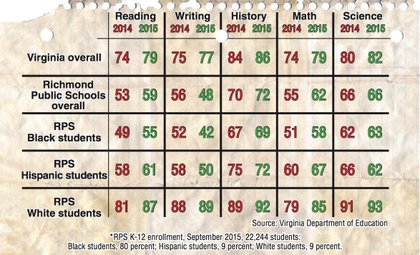Tale of the tests
Richmond SOL scores rise, but still below state average
Jeremy M. Lazarus | 8/13/2015, 1:28 p.m. | Updated on 8/14/2015, 7:53 a.m.
The good news: More students in Richmond Public Schools passed state Standards of Learning tests in reading, history and math in spring 2015 compared with the previous year. That’s in line with the state trend of rising pass rates.
The bad news: The pass rates during Superintendent Dana T. Bedden’s first full academic year show the percentage of the city’s 23,000 students succeeding on the SOL tests in Richmond is still well below state pass rates in core subjects.
And in one area, writing, the percentage of Richmond students who passed dropped eight percentage points — from 56 percent in 2014 to 48 percent, according to results released Tuesday by the Virginia Department of Education.
The pass rates will determine school accreditation, which will be announced later. This year, only 11 of the city’s 44 schools were fully accredited based on 2014 test results.
In a statement issued Wednesday, Dr. Bedden found the results “clearly indicate that Richmond Public Schools continues to make progress.”
He pointed to “the strides made by our students in mathematics (up seven percentage points from 2014), reading (up six percentage points from 2014) and history (up two percentage points from 2014).”
He also acknowledged that a drop in the writing pass rate “shows that opportunities for improvement remain. These results further underscore the importance of the Academic Improvement Plan (AIP) we have designed to (help) our students improve their academic performances so they can meet or exceed academic standards in the years ahead.”
School Board Chairman Donald Coleman, in a separate statement to the Free Press, noted that “RPS is committed to seeing SOL scores improve” and expressed his belief that the AIP would make that happen and result in more fully accredited schools.
The 7th District representative also called on all residents to “do all we can to help our students recognize the importance of education” and to support public education as a “top priority” so Richmond can reach “its potential as a thriving city.”
Kristen Larson, the School Board’s vice chair, stated in an email that the positive test results provide “a good start to this year’s implementation of the district’s Academic Improvement Plan.
“Overall the district is headed in the right direction, but there is still a lot of room for improvement and work to be done,” the 4th District representative added.
The results make it clear that Dr. Bedden’s efforts to turn around academic achievement remain a work in progress.
Consider the results on SOL reading tests. Across the state, the VDOE reported that 79 percent of students passed their SOL reading tests in 2015, up 5 percentage points from the 74 percent that passed in 2014.
In Richmond, 59 percent of students passed reading tests in grades three through high school, up six percentage points from the 2014 result of 53 percent, but still 20 percentage points below the state.
In the math arena, 62 percent of Richmond students passed SOL tests, up 7 percentage points from 2014 when 55 percent passed. But across the state, 79 percent of students passed the 2015 round of SOL math tests, 17 percentage points higher than the city’s pass rate.
Among the unsolved mysteries in reviewing the test results is the collapse of learning at the middle school level. It has been going on for years, and no one yet has a solution, even though the city school system and the VDOE have been investing heavily in consultants and specialists to try and change the situation.
Reading is a prime example. During the spring, 66 percent of fifth-grade students in Richmond passed their SOL reading tests and 78 percent of high school students passed their reading tests.
However, just 46 percent of Richmond’s sixth-grade students passed their SOL reading tests, even though they are just one year older than the fifth-graders.
And in eighth grade, 46 percent of Richmond students passed the most recent round of SOL reading tests. That was an improvement from the 33 percent pass rate of 2014, but still less than 50 percent and far short of the SOL success rates among younger and older students.
Among the most seriously troubled middle schools is Martin Luther King Jr. in the East End, which fills one of the city’s newest school buildings that opened in January 2014.
Despite the virtually brand new space, only a tiny fraction of the students apparently are paying attention in class.
According to the results the state released, only one in four Martin Luther King Middle School students in grades six to eight passed their SOL reading tests.
Among the school’s eighth-graders tested in reading in the spring, only 23 percent had passing scores, down 9 percentage points from spring 2014 test results.
In math, less than one-third of the Martin Luther King students passed the SOL tests in each grade. The lowest percentage came in seventh grade, where only 16 percent of students passed their math SOL tests. That was an improvement from 2014, when only 12 percent of the school’s seventh-graders passed the math test.
The school-by-school results show some extremely positive stories, as the following sample shows.
This year, at Fairfield Elementary School, located in an East End public housing community, 90 percent of fifth-graders at the school passed their SOL reading tests, a huge gain from 2014 when only 45 percent did.
The pass rates in math were equally stellar for the fifth grade, jumping from 68 percent in 2014 to 92 percent this year.
At Albert Hill Middle School in the West End, the pass rate in sixth-grade math rose from 27 percent in 2014 to 55 percent this year.
And in eighth-grade reading, the pass rate at Albert Hill rose from 32 percent in 2014 to 70 percent this year.
Franklin Military also saw big leaps in pass rates in reading in its middle school. The sixth-grade pass rate in reading jumped from 40 percent in 2014 to 83 percent this year; the seventh-grade reading pass rate climbed from 42 percent in 2014 to 78 percent this year; and the eighth-grade reading pass rate rose from 55 percent in 2014 to 71 percent.
The eighth-grade pass rate in math also jumped from 31 percent in 2014 to 67 percent at the public military school.
A closer look at the figures also shows that there are learning gaps between different groups — just as is the case statewide.
The VDOE acknowledged that pass rates for black and Hispanic students still trail white students, with that trend also evident in Richmond.
The results do not come with an explanation for the wide divide between the different groups.








